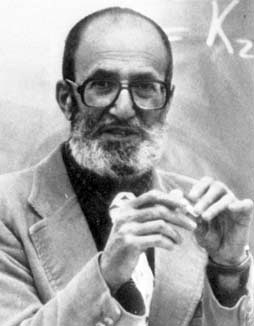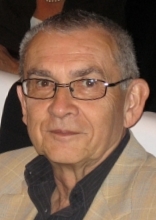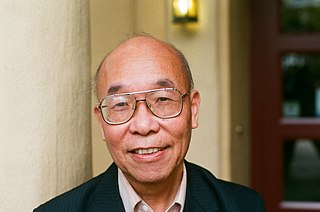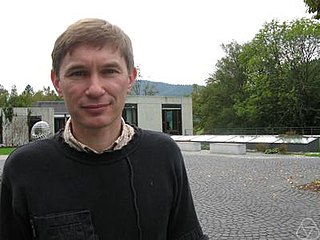Related Research Articles

Paul Richard Halmos was a Hungarian-born American mathematician and statistician who made fundamental advances in the areas of mathematical logic, probability theory, statistics, operator theory, ergodic theory, and functional analysis. He was also recognized as a great mathematical expositor. He has been described as one of The Martians.

Yuri Ivanovich Manin was a Russian mathematician, known for work in algebraic geometry and diophantine geometry, and many expository works ranging from mathematical logic to theoretical physics.
In ring theory and homological algebra, the global dimension of a ring A denoted gl dim A, is a non-negative integer or infinity which is a homological invariant of the ring. It is defined to be the supremum of the set of projective dimensions of all A-modules. Global dimension is an important technical notion in the dimension theory of Noetherian rings. By a theorem of Jean-Pierre Serre, global dimension can be used to characterize within the class of commutative Noetherian local rings those rings which are regular. Their global dimension coincides with the Krull dimension, whose definition is module-theoretic.

Nathan Jacobson was an American mathematician.

Irving Kaplansky was a mathematician, college professor, author, and amateur musician.

Robert Vaughan Moody, is a Canadian mathematician. He is the co-discoverer of Kac–Moody algebra, a Lie algebra, usually infinite-dimensional, that can be defined through a generalized root system.
The Oswald Veblen Prize in Geometry is an award granted by the American Mathematical Society for notable research in geometry or topology. It was funded in 1961 in memory of Oswald Veblen and first issued in 1964. The Veblen Prize is now worth US$5000, and is awarded every three years.

Olive Clio Hazlett was an American mathematician who spent most of her career working for the University of Illinois. She mainly researched algebra, and wrote seventeen research papers on subjects such as nilpotent algebras, division algebras, modular invariants, and the arithmetic of algebras.
In mathematics, a separable algebra is a kind of semisimple algebra. It is a generalization to associative algebras of the notion of a separable field extension.
In mathematics, the Chevalley–Shephard–Todd theorem in invariant theory of finite groups states that the ring of invariants of a finite group acting on a complex vector space is a polynomial ring if and only if the group is generated by pseudoreflections. In the case of subgroups of the complex general linear group the theorem was first proved by G. C. Shephard and J. A. Todd who gave a case-by-case proof. Claude Chevalley soon afterwards gave a uniform proof. It has been extended to finite linear groups over an arbitrary field in the non-modular case by Jean-Pierre Serre.
Maurice Auslander was an American mathematician who worked on commutative algebra, homological algebra and the representation theory of Artin algebras. He proved the Auslander–Buchsbaum theorem that regular local rings are factorial, the Auslander–Buchsbaum formula, and, in collaboration with Idun Reiten, introduced Auslander–Reiten theory and Auslander algebras.

Tsit Yuen Lam is a Hong Kong-American mathematician specializing in algebra, especially ring theory and quadratic forms.
Nolan Russell Wallach is a mathematician known for work in the representation theory of reductive algebraic groups. He is the author of the two-volume treatise Real Reductive Groups.
James Edward Humphreys was an American mathematician who worked in algebraic groups, Lie groups, and Lie algebras and applications of these mathematical structures. He is known as the author of several mathematical texts, such as Introduction to Lie Algebras and Representation Theory and Reflection Groups and Coxeter Groups.

Birge Katharina Huisgen-Zimmermann is a mathematician at University of California, Santa Barbara specializing in representation theory and ring theory.
Joseph Miller Thomas was an American mathematician, known for the Thomas decomposition of algebraic and differential systems.

Kari Kaleva Vilonen is a Finnish mathematician, specializing in geometric representation theory. He is currently a professor at the University of Melbourne.
Victor Lenard Shapiro was an American mathematician, specializing in trigonometric series and differential equations. He is known for his two theorems on the uniqueness of multiple Fourier series.

Alexander A. Voronov is a Russian-American mathematician specializing in mathematical physics, algebraic topology, and algebraic geometry. He is currently a Professor of Mathematics at the University of Minnesota and a Visiting Senior Scientist at the Kavli Institute for the Physics and Mathematics of the Universe.
References
- ↑ Birth year from German National Library catalog entry, retrieved 2018-11-30.
- ↑ Barbara L. Osofsky
- ↑ B. L. Osofsky, Homological properties of rings and modules (Doctoral dissertation, Rutgers University, 1964).
- ↑ T. Y. Lam, Lectures on Modules and Rings Graduate Texts in Mathematics, 189 (Springer-Verlag, New York, 1999), p. 224.
- ↑ B. L. Osofsky, Homological dimension and the continuum hypothesis, Trans. Amer. Math. Soc. 132 (1968) 217–230.
- ↑ B. L. Osofsky, Homological dimension and cardinality, Trans. Amer. Math. Soc. 151 (1970) 641–649.
- ↑ Barbara Osofsky at the Mathematics Genealogy Project
- ↑ Charles Weibel. "A History of Mathematics at Rutgers" . Retrieved Feb 1, 2015.
- ↑ Peter L. Duren, Richard Askey, Uta C. Merzbach (1989) A Century of Mathematics in America American Mathematical Soc., p. 395
- ↑ List of Fellows of the American Mathematical Society